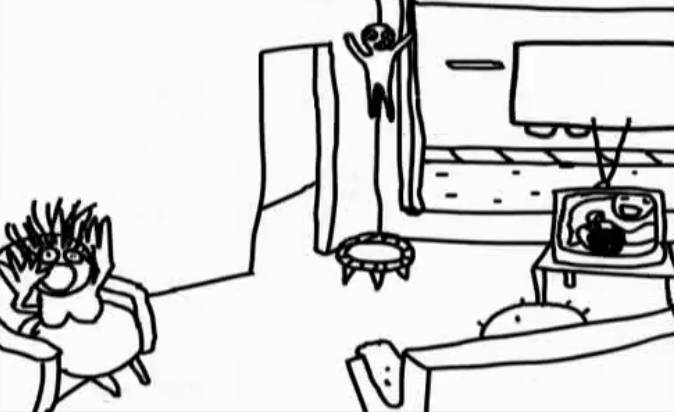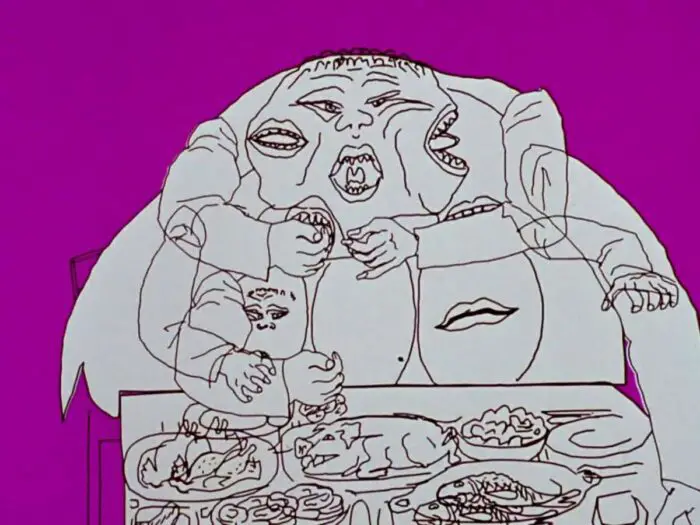The most visceral medium in cinema might well be animation. And despite the majority of the field being dedicated to children, there has always been a movement in animation that uses the seemingly limitless art form to speak to adults specifically. The genre demands a more explicitly visual approach, and animation’s purposefully expressive colors, heightened sound effects, science-defying atmosphere, and unending symbolism—when taken seriously for an adult audience—can provide just as much, if not more, meaning as live-action filmmaking.
Animation can appeal to surface emotions. As children, be it watching the Saturday morning cartoons, or catching the more education-based programs like Dora the Explorer and Mickey Mouse Clubhouse, there is an over-expressive nature that demands attention. For a more innocent mind, the intent is clearly to get the child to focus on something specific, and anyone who has kids knows you need loud and colorful actions to draw a child’s ever-wandering attention.
Adult animation doesn’t veer too far from this concept. It still provides a loud and vibrant product but, understanding its audience, asks for attention not quite on the “Wow, that’s bright!” surface level, but on the deeper and philosophical side of things. Animators have the ability to evoke emotions on so many different spectrums across so many different age groups that it is no coincidence animation has been a staple of cinema since its very creation. But finding meaningful animation for adults can be difficult, as demand, due to the often generalized “kid” nature of animation, has limited supply.
That is where Criterion comes into play. Though animated features and shorts make up a small part of their streaming library, and, as far as I can tell, there isn’t a collection of animated shorts available on physical media that they sell, the Criterion Channel does not disappoint by offering an excellently curated selection of adult animation spanning multiple decades and varying styles, to engage, if not the kid in us, then the experimental filmgoer, looking for new challenges.
Below is a look at eight short animated films the Criterion Channel offers. Hopefully, this will either satiate your need for more adult “toons” or will introduce you to a little-heralded but very powerful form of cinematic storytelling.
DumbLand (2002)

“I am a one-armed duck fucker.”
Director: David Lynch
Story: In eight five-minutes-or-less episodes, David Lynch introduces us to a nameless family of angry and, as expected, quite dumb people who find themselves annoyed by neighbors, nearby traffic, sick family members, random visitors, singing ants, and…look, I have no idea what is actually going on.
Thoughts and Analysis: Like many David Lynch projects, the story’s point is hardly ever what matters. Sometimes it is the wild journey and not the destination. Hell, there might not even be a destination. DumbLand functions much like the infamous “sweeping” scene in Twin Peaks: The Return. It’s there, it is kind of obnoxious, kind of mesmerizing, and ultimately pointless. Or is it?
DumbLand, in its entirety, is basically a 33-minute version of that sweeping scene, but with incredible violence, bizarre non-sequiturs, and the (hopefully) intentionally bad drawing style as a bonus. I’ve read a lot of reviews citing the animation as “crude,” but that might be too generous.

But crude is a lifestyle in DumbLand: husbands beat their wives, parents slap their children, people fart and vomit like it’s going out of style while cursing like drunken sailors. Is this possibly how Lynch saw a Bush America in the wake of 9/11? Or is it just another twisted genius making you watch a bunch of sweeping and, years later, write about it?
Bonus Features on Criterion for DumbLand: none
Availability: DumbLand is only streaming on the Criterion Channel and is not assigned a spine number.
Lynch’s DumbLand was not restricted to just eight tiny episodes. One of the characters got in on one of Lynch’s famed online weather reports. Sort of.
Hunger (1973)

Director: Peter Foldes
Story: A slim businessman starts his day off by nibbling at snacks while going about his normal, mundane business. But on his return home, his need to try more and more food lead him down an unstoppable path of gluttony and personal destruction.
Thoughts and Analysis: Like a lot of animation, Hunger heightens its wordless story by over-exaggerating the presented images, making the action simultaneously literal and metaphorical. Hunger captures the psychological torment of gluttony. As someone who has suffered from an unconscious need to eat, the film accurately captures not only the physical changes your body makes when it is over-indulged but the mental aspect as well. Where others may see a husky man, I sometimes look in the mirror and see an ever-increasing monster.
Director Foldes’ film was one of the first of any sort to use CGI, and the slightly crude (though revolutionary for its time) morphing effects add an uneasy edge as our protagonist slowly morphs from a pretty standard-looking man into a multi-mouthed monster, consuming all in his wake. With purposefully repetitive and slightly annoying theme music underscoring the action, Hunger is a visual feast but, ironically, one you won’t encourage second helpings.
Extras on Criterion for Hunger: none
Availability: Hunger is only streaming on the Criterion Channel and is not assigned a spine number.
Neighbours (1952)

Director: Norman McLaren
Story: The appearance of a small, yellow flower turns friendly neighbors into mortal enemies when they argue and fight over whose yard the flower belongs in.
Thoughts and Analysis: This might appear to be a bit of a cheat. As you can see from the picture above, this is a live-action film. And though it is an extremely exaggerated fictional tale, it won the Best Documentary, Short Subjects Academy Award in 1952. So where does a live-action “documentary” fit into an animation discussion?
Canadian filmmaker McLaren specifically made Neighbours to have the physical reality and rule-breaking science of a cartoon, down to the physical actions of the actors, the movement of the camera, and, most importantly, the incredible ultraviolence enraged cartoon characters use against one another when the plot demands it. Think Wile E. Coyote having a large ACME anvil fall on his head. The real actors in this film portray that type of moment, complete with the large bell-ringing sound when the impact is made and the exaggerated physical consequences (from which they quickly recover) when suffering profound punishment.
Neighbours is a hilarious look at what happens when cartoons become reality, which is why it deserves inclusion on this list and might explain the Academy’s confusion on how to define it.
Extras on Criterion for Neighbours: none
Availability: Neighbours is only streaming on the Criterion Channel and is not assigned a spine number. Check out more info on the film’s history.
Old Man (2012)

…because she’s propograndiiiizzzzed. Propograndized with that helter-skelter shit that the Roman Catholics have been preaching for the last 850 yeeeeeears. The Italian mafiosos. Who are all dead now. The dead is controlling the living. The people in the graveyards are controlling our lives.
Director: Leah Shore
Story: The meandering thoughts of Charles Manson, as recorded by a journalist over the phone, are given an imaginative visual translation in this short but trippy film.
Thoughts and Analysis: With Once Upon A Time…in Hollywood being a big hit in 2019, Charles Manson is once again all the rage. But has he ever not been popular? The mesmerizing force with a swastika tattoo on his forehead has influenced murders, sure, but has also created a mini-industry of biographers, filmmakers, and podcasters who reflect on the steadily rising fascination with serial killers and cults.
Old Man is a unique interpretation of the Manson institution, never trying to judge its subject directly but by physically manifesting his words; to make flesh the ideas and concepts that flow through his head, if that is even possible. This isn’t a fan film or an attempt to positively humanize Manson.
Instead, it allows the audience to become terrified (or excited) by the man’s uncensored words and thought patterns. In turn, it may create new fans, but it also makes clear the creativity and fascination with the mentally disturbed and how they operate. As a purely historical exercise on someone who has influenced culture, for better or worse, this is as honest an interpretation of Manson’s “work” as there can be.
Extras on Criterion for Old Man: a short discussion with director Shore.
Availability: Old Man is only streaming on the Criterion Channel and is not assigned a spine number.
Pussy (2016)

Director: Renata Gasiorowska
Story: A young girl wants to enjoy herself on a boring day, trying to find the right conditions and comfort level to masturbate. But her vagina has a mind all its own and takes the girl on a journey of experimentation and discovery.
Thoughts and Analysis: Pussy is the first of two female-directed, body-positive animated films that utilize no dialogue but capture the essence of being female in a world obsessed with the female appearance. While Pussy is certainly more lighthearted than Luca Toth’s Superbia (which we’ll look at next), it still manages to show the everyday struggle women have with not only the male gaze but with how the female body works as it increasingly changes.
Director Gasiorowska’s light-hearted approach is portrayed by making our main heroine’s vagina become a fully alive, cute, bug-like creature that detaches from the girl’s body to become inquisitive about its surroundings. It tries new sensations, realizes what is good and to touch, and even scares away a peeping tom!
By personifying the vagina itself, it allows the girl, and thus the audience, to experience the confusion and exploration of sexuality, sensation, and personal discovery on a more metaphorical basis. And it shows that a woman’s sexuality is not some complicated or taboo subject, but perhaps one fit for a, dare I say, fun (*gasp*) look at a woman’s sexual needs, which are so often overshadowed by those of men.
Extras on Criterion for Pussy: none
Availability: Pussy is only streaming on the Criterion Channel and is not assigned a spine number.
For more information on the film and Gasiorowska, check out this interview.
Superbia (2016)

Director: Luca Toth
Story: The world is divided into two groups: large women who roam the woods, using their breasts for arms and their size for dominance, and smaller men who hide in caves and experiment with objects. When two women become fascinated with one of the more peculiar men, a sexual conquest begins that shakes the foundations of their society.
Thoughts and Analysis: I’m not actually totally sure if what I described above is accurate, but the plot might not be the point. Toth’s film is certainly more figurative and symbolic, using reversed gender roles to make a statement on how we view those genders in real life.
Toth mostly does this by using objects of lust as practical items. For the women, breasts are the hands and arms. A man’s penis is seen as a conquerable item, not a tool of power. The men are all thin and relatively fit but, as a result, are seen as weak and fragile. The women, allowed to grow large and, for lack of a better term, “fat,” are the strong ones, exerting their power over the men. And their larger nature is not seen as a drawback for the men, but something both desired and feared.
It is an intriguing look at power dynamics that makes men, if they are paying attention, look at how they place certain expectations on women in terms of appearance and freedom. When these restrictions are suddenly turned on men, it shows you how pervasive and disturbing the patterns are that has become, sadly, commonplace in society.
Extras on Criterion for Superbia: none
Availability: Superbia is only streaming on the Criterion Channel and has not been assigned a spine number.
For a look inside Toth’s thought process behind Superbia, check out this interview.
Yearbook (2014)

“And that’s when I remember: Cat Stevens. But then I realize: he’s probably not that important.”
Director: Bernardo Britto
Story: A man is tasked with documenting all the world’s “important” history before an alien’s world-destroying rocket hits Earth in 17 years. The only problem: What is considered important and worthy of recording in the vast and complicated history of mankind?
Thoughts and Analysis: Yearbook was the first film I watched for this column, and it was the perfect film to introduce me to Criterion’s adult animation collection. If you were to only watch one film from this list, Yearbook might be the best one in terms of explaining how adult animation works on a fundamental level.
In only five minutes, Britto’s soothing narrations takes us inside the mind of a man (no name is given) who is tasked with recording all of “important” human history on a recording device so that children fleeing the earth from alien invasion will know what they left behind. This herculean task becomes a 17-year burden for the man, as he is left alone to determine what is truly important, not just to him but to all humanity.
In the end, the journey becomes more personal as he discovers that history is what you make of it and that even the most mundane things can define your existence, even if you don’t see it right away. It was a genuinely touching look at human relationships and the idea that sometimes an entire universe is internal, not external.
Extras on Criterion for Yearbook: an introduction by Britto.
Availability: Yearbook is only streaming on the Criterion Channel and has not been assigned a spine number.
Weekends (2017)

Director: Trevor Jimenez
Story: A young boy spends his weeks at home with his clumsy but dutiful mother and some weekends with his cool, samurai-loving dad. But when the two parents begin to find new companions, the boy must deal with the ever-changing environment that comes with inviting two new people into his safe spaces.
Thoughts and Analysis: Weekends might be the most emotionally moving of the films discussed in this column. It is the rare film—both in animation or in live-action—to successfully capture the complex essence of youth perfectly. Though an adult, director/writer Jimenez taps into the confusing and oversized lifestyle of a young boy by capturing the perspectives the childhood gaze has on adult relationships. He also manages to project an environment where one childish foot is always in the realm of fantasy and fun in even the most mundane of places, such as a bedroom under construction, or a living room overloaded with boxes.
Our nameless protagonist, going from home to home as the seasons change, is always looking up at the adults, or observing secretly, from above, his parent’s quiet moments, not always understanding what is going on. He is always seeing things on the periphery, understanding there are signs to be read but not fully grasping their meaning.
It is no wonder the film, which portrays childhood from an adult lens, was nominated for the Best Animated Short Academy Award in 2018. It might be the perfect example, as explained in the introduction of this column, as to why the animated genre can transcend boundaries of age and appeal to all the timelines of an audience member’s life.
Extras on Criterion for Weekends: none
Availability: Weekends is only streaming on the Criterion Channel and has not been assigned a spine number.
Please join me in November when I look at a selection of the Criterion Channel’s documentary library. In December, I’ll be exploring the Criterion vault for films that are “Trippy and Strange.”
If you are interested in seeing my other columns digging through the Criterion Channel’s streaming offerings, please click the links below:
Also, please check out the site tag The Criterion Collection for individual film reviews of movies both in the physical Collection and streaming on the Channel from other excellent writers here at 25 Years Later.
Lastly, follow me on Letterbox’d so we can discuss what you are watching!



